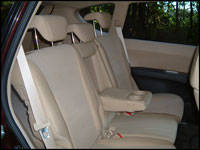 |
| Second-row legroom in the Tribeca is very generous when the 3-person bench is positioned fully rearward, but doing so eradicates legroom in the third-row bench. (Photo: Rob Rothwell, Canadian Auto Press) |
The front seats are quite firm and suitably supportive. As with some other vehicles without power adjustable pedals and a telescoping steering wheel, I found myself positioned too far from the steering wheel when the driver's seat was set to accommodate my legs. This isn't a problem exclusive to the Tribeca. I have encountered it numerous times before, leading me to question the normality of my limb length ratio. Second-row legroom in the Tribeca is very generous when the 3-person bench is positioned fully rearward, and that's great except doing so entirely eradicates legroom in the 2-person third-row bench. If both the second and third rows are occupied, expect a bit of fore and aft second-row jostling before the available legroom is fairly distributed.
As with most SUVs and crossovers of similar size to the Tribeca, third-row seating is awkward to access and very confining for anyone large enough to shop in the adult section of the local haberdasher. When the third row seat is stowed, the Tribeca reveals generous cargo-handling capacity, which increases to a substantial 2,106 litres (74.4 cu ft) when the second row is also flattened. Along with this bulk space is a dandy collection of tuck-away cubbies and cup holders that can be so handy during long trips.
And you can bet that long trips in the B9 Tribeca will be most pleasurable. Supplying power to all four-corners is a 3.0-litre (183 cu in) DOHC
 |
| This smooth operator spins out 250-horsepower at 6,600 rpm and 219 foot-pounds of torque at 4,200 rpm. (Photo: Rob Rothwell, Canadian Auto Press) |
aluminum-alloy, 24-valve 6-cylinder horizontally opposed Boxer engine, supplemented with Subaru's Active Valve Control System (AVCS) and Active Valve Lift System (AVLS). This smooth operator spins out 250-horsepower at 6,600 rpm and 219 foot-pounds of torque at 4,200 rpm. A benefit of Boxer engines is their compactness, which contributes to a lower hoodline and front-end profile. This also improves the vehicle's centre of gravity by keeping engine mass low in the chassis, something Subaru refers to as "engineering symmetry." Boxer engines are very good at canceling out vibration by firing opposing cylinders simultaneously. Within normal driving parameters the Boxer-6 is very smooth and quiet, only announcing its presence with any sort of glee when pushed hard and revving high.




